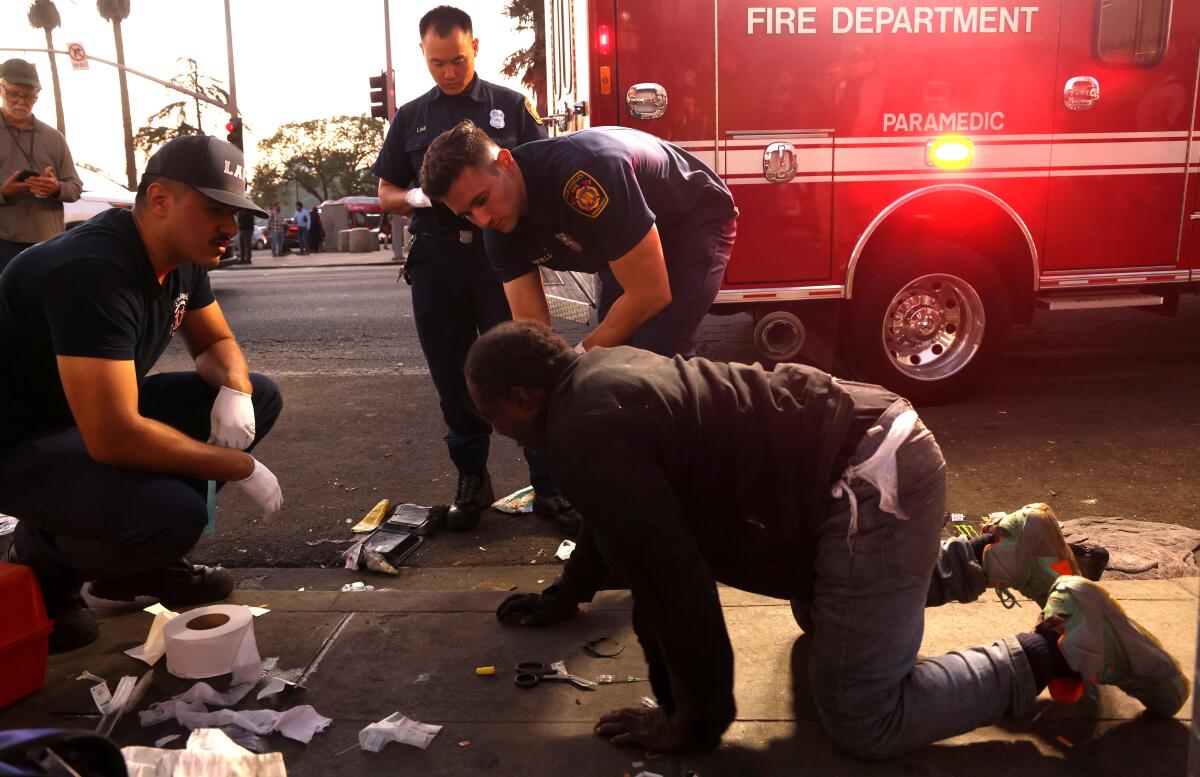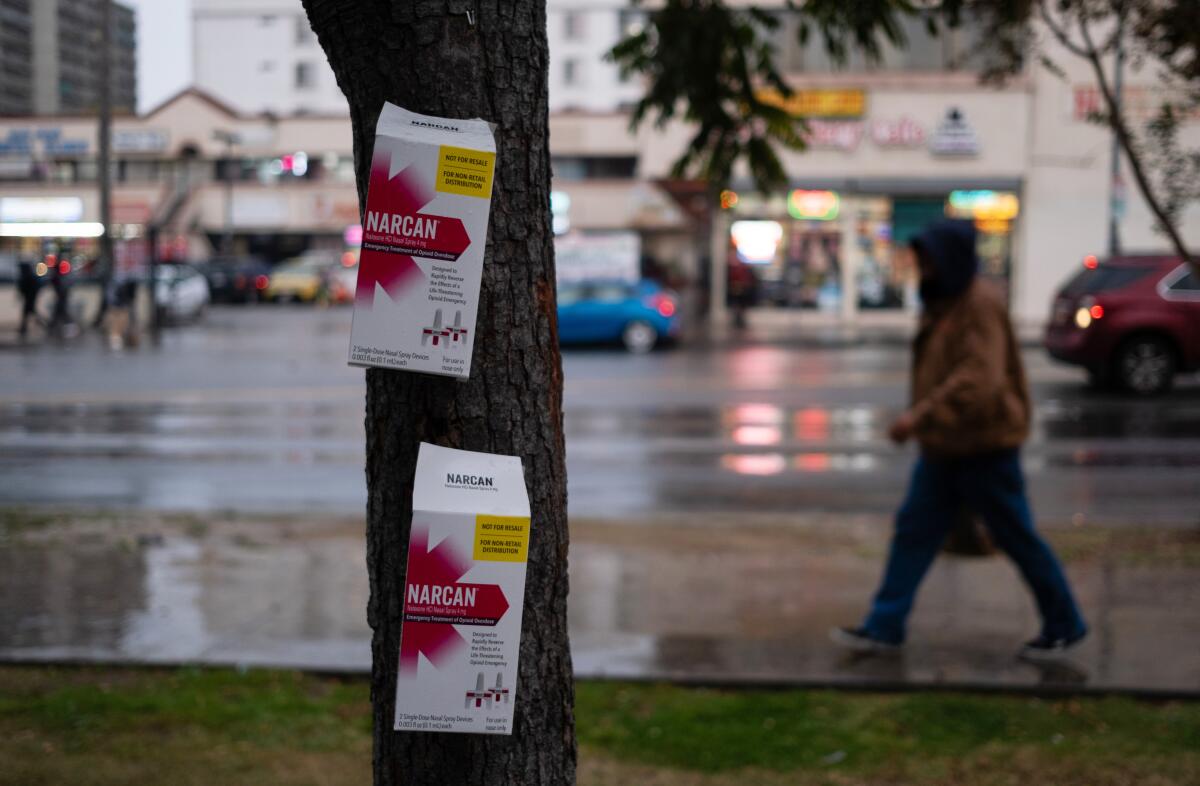L.A. County sees a sharp decline in drug overdose deaths in 2024

- Share via
- The 2024 overdose death toll of 2,438 is the lowest since 2019, and a drop from the 3,137 deaths recorded in 2023.
- While fentanyl remained the leading cause of accidental overdose deaths, its share dropped to 52% of all cases, down from 64% in 2023.
- Health officials credited measures including large-scale investments in drug treatment and overdose prevention for a sharp decline in drug overdoses.
Accidental drug overdose and poisoning deaths plunged by 22% in Los Angeles County last year, according to a new report, marking the most substantial single-year decline on record.
The 2024 overdose death toll of 2,438 is the lowest since 2019 and a notable drop from the 3,137 deaths recorded in 2023. The sharpest decline was in fentanyl-related deaths, which fell 37% from 2,001 deaths in 2023 to 1,263 in 2024, according to a report released Wednesday from the L.A. County Public Health Department.
Health officials credited measures including large-scale investments in drug treatment and overdose prevention for the reversal of a long upward trend.
“It demonstrates that what we’re doing is working,” said Dr. Gary Tsai, director of the county’s Substance Abuse Prevention and Control division, citing increased prevention measures and other efforts.
Even so, the county still suffers “very high numbers of overdose deaths,” Tsai said. “Now is actually the time to be pressing our foot on the gas even more.”
While fentanyl remained the leading cause of accidental overdose deaths, its share dropped to 52% of all cases, down from 64% in 2023. Deaths involving methamphetamine also declined by 20%, the county report said.
Dr. Pope Moseley, a lung and intensive care physician and biomedical sciences researcher at Arizona State University, welcomed the decline in fentanyl deaths and noted that it reflects a broader national trend.
At the same time, Moseley noted that national figures show a rise in another kind of drug abuse — the combination of methamphetamines and opioids.
“Over 60% of opioid overdoses right now contain methamphetamine,” he said. “Compared to 2016, that’s a lot different.”
The county report also detailed drug deaths by race, gender, age group and other factors.
By age, adults aged 40-64 made up nearly half (47%) of all fentanyl deaths, followed by adults aged 26-39 (38%). There were lower rates for other age groups.
When adjusting for population size, adults 26-39 had the highest fentanyl overdose death rate at 22.7 deaths per 100,000 people, followed by adults aged 40-64, young adults aged 18-25, people age 65 and over, and youth 17 and under. The report noted that since 2021, rates among young adults aged 18-25 have consistently decreased.
By race, Latino residents accounted for the highest raw number of fentanyl deaths in 2024 (508 deaths), followed by white (456), Black (232) and Asian (26) residents.
However, the fentanyl overdose death rate per 100,000 was highest among Black residents — 29 per 100,000, nearly triple that of Latino residents at 10.5 per 100,000. Deaths were 17.4 per 100,000 for whites. Black county residents made up just 8% of the county’s population but nearly one in five fentanyl-related deaths.
By gender, similar disparities to 2023 remained, with males having a rate more than four times that of females.
The report highlights the continued disparities associated with socioeconomic status.
Residents in census tracts where more than 30% of families lived below the federal poverty line had a fentanyl overdose death rate nearly four times that of those in more affluent areas. These figures underscore the structural inequities that shape who is most at risk of overdose and who has access to resources, according to the report.
This year’s report builds on a shift first observed in 2023, when drug-related deaths in Los Angeles County plateaued for the first time in a decade, following years of consistent increases.
In contrast, the 2024 data reflect a more widespread and significant downturn across nearly all demographics and regions, with sharp declines in both raw death counts and population-adjusted rates. Still, persistent racial and economic disparities identified in last year’s report remain relevant: Black residents continue to experience the highest fentanyl overdose death rate per capita, and fatality rates remain disproportionately high in the county’s poorest neighborhoods.
Despite these continued disparities, Public Health officials are hopeful that their concerted efforts are having a meaningful impact on saving lives.
Public Health officials say that recent expansions in prevention, treatment services and so-called harm reduction measures — such as broader access to naloxone, fentanyl test strips and safer consumption sites — played a crucial role in the dramatic reductions reported in the study.

In 2024 alone, investments in prevention programs increased by over 260%, treatment services by 275% and harm reduction programs by 500%, county officials said.
Initiatives such as the Fentanyl Frontline campaign and the creation of ByLAforLA.org, a community resource hub, aimed to expand access to naloxone, reduce stigma and connect residents to care and support services.
Looking ahead, Tsai noted early signs for 2025 are cautiously encouraging.
“Preliminarily, we are seeing ongoing reduction in overdose deaths when we compare January 2025 to January 2024,” he said. That trend, he added, diverges from national preliminary data, which suggests an uptick in early 2025, though he cautioned these results can change as medical examiners continue processing cases for January 2025.
Even as the county celebrates progress, Tsai emphasized that longstanding inequities, especially those related to race, poverty and access to care, continue to shape overdose risks.
“Although we’ve seen the numbers go down across the board, disparities have been consistent,” he said. “Clearly, even though we’re seeing the overdose numbers go down, we still have a lot of work ahead of us.”
In a statement, Public Health Director Barbara Ferrer said that “sustained investment in prevention, treatment, and recovery services is essential to ensuring every person in our community has the opportunity to live a healthy, supported life.”
Los Angeles County residents can access 24/7 support for substance use services by calling (800) 854-7771.








